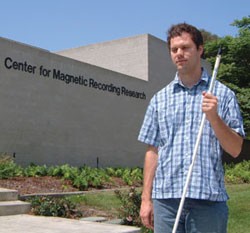Breaking Down Barriers: Calit2 Researcher John Miller
|
2.05.04 - John Miller is doing postdoctoral research in communications theory and systems for Calit² after receiving his Ph.D. in Electrical and Computer Engineering in June 2003. In his dissertation, Miller developed a new approach to coding that could pave the way for hard disk drive manufacturers to adopt a powerful type of code that, on the surface, looks more appropriate for digital cell phones. "John was a terrific student and is now a terrific researcher. He has the uncanny ability to simultaneously grasp the details of a complicated problem," says Jacobs School of Engineering professor Jack Wolf., a chaired professor in UCSD's Center for Magnetic Recording Research (CMRR). "He would come to my office with a long proof of a theorem entirely in his head. John's determination and accomplishments have made him a role model for all of the graduate students in CMRR."
His accomplishments are even more notable, because John Miller is blind.
He became the first blind student to earn a Ph.D. in electrical engineering from the Jacobs School, overcoming daily obstacles-from reading an algorithm on the whiteboard, a Powerpoint presentation, a print textbook, even e-mail. "I came here and had a delightful time inventing brand new things," says Miller, who has been blind since early childhood. "I wanted to advance the art of engineering and mathematics, and I also wanted to break down some of the barriers that have made it almost impossible for young blind students to pursue careers in science and engineering." Miller is currently President of the Science and Engineering Division of the National Federation of the Blind.
Miller grew up in Omaha, Nebraska, and got his undergraduate and Master's degrees - with honors - from Stanford University in 1992. After Stanford, Miller took a job with a startup company in San Diego. "I was intrigued because the company was founded by the author of one of the classic textbooks in the communications field," recalls Miller. That author was Irwin Jacobs, and the company was QUALCOMM.
In 1996 Miller left QUALCOMM for a lead systems engineering job at Rockwell Semiconductor Systems, also in San Diego. Gradually, however, he became convinced that he wanted to teach and publish in academic journals. UCSD was his first choice. "I came here because I wanted to be an inventor and to work with the best professors in the world, and they happened to be right here in San Diego," says Miller. In particular, he wanted to work with Jack Wolf, a leader in the field of information theory.
"My success at UCSD has everything to do with Jack's belief in me and his generosity," insists Miller. "I like the Jacobs School, but the university as a whole is not geared to meeting the needs of blind students, especially in disciplines where Braille textbooks are practically non-existent. I need a part-time reader, a Braille printer, and to get chapters put into Braille. There is funding by the Office for Students with Disabilities, but for university course work only. There is no general university fund to assist with the graduate research of disabled students. As my advisor, Jack bore all those costs. For both coursework and research, Jack was invaluable in helping me get through as a blind person."
According to Miller, blind students face particular obstacles when attending classes - especially engineering classes where diagrams and mathematical symbols are commonplace. "When I'm in a seminar, I identify myself and request that the professor explain the flow of a diagram," explains Miller. "Or I ask very specific questions like: What was the performance measure at this signal-to-noise ratio? The lecturer may have put up five different curves, so I have to ask that he explain each one. I also ask them to e-mail their Powerpoint presentations to me ahead of time, so I can go through them with a reader who describes them in detail. And if there is an important diagram, I may ask my assistant to make it into a raised-line diagram."
For his dissertation, Miller developed a new set of Low Density Parity Check (LDPC) codes for use in magnetic storage devices such as hard disk drives. Current LDPC codes can robustly detect a signal in the presence of noise better than other codes, and they may see future use in digital wireless phones, to make voices come in clearer. "The problem with LDPC codes is that with a certain probability, they fail," Miller explains. "With cell phones that's okay, because we are willing to accept fadeout or even dropped calls occasionally. But for a hard disk drive, you need to be able to retrieve a message with near certainty - with a failure rate of less than one in 1015." According to Miller, the new codes he developed are much more reliable, potentially paving the way for their use throughout the magnetic storage industry. "It's a theoretical solution that has a practical implementation," says Miller. "It's something that the hard drive industry needs today."
Miller worked as a postdoctoral researcher in the Jacobs School's Electrical and Computer Engineering department, and now devotes his time to the Calit² project (see main story) that marries his twin interests: engineering innovation, and assistive devices to make life easier for people with sight or hearing disabilities-hoping to make it that much easier for the next blind student to achieve success in the field of engineering.
Related Links
Related Articles
Wireless Navigation for the Blind and Visually Impaired


